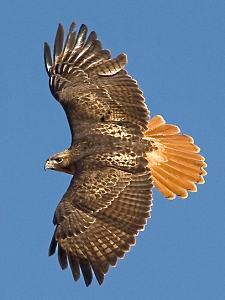Wildlife - Species

Species Specific Regulations
Red-tailed Hawk
The Red-tailed Hawk and other birds of prey are protected by South Carolina state wildlife law section 50-11-852 which states that it is: "unlawful to molest or kill birds of prey."
Red-tailed Hawk (Buteo jamaicensis)
Description
Red-tailed hawks are the most common members of the genus Buteo in North America. The name Buteo means "buzzard," a term that correctly refers to some Old World hawks but is commonly misused to refer to vultures. Locally, red-tailed hawks are also known as hen hawks or rabbit hawks. They are medium sized birds, reaching 46-64 cm (18-25 in) in length with a wingspan of 1.2 m (4 ft). Their plumage is dark brown above and white below. The belly is streaked with brown, and the tail is 'solid' rust color (with a black subterminal band). There are two variations in coloration in the red-tailed hawk, the light phase and the dark phase. An individual hawk will retain the coloration that it is born with throughout its life.
Juvenile hawks resemble the adult except in tail plumage. The juvenile tail is usually tan colored with thin black stripes, while the adult has the rust-colored tail with a black subterminal band. Red-tailed hawks are stockier and have broader, more rounded wings than both the red-shouldered and broad-winged hawks. Also, both the red-shouldered and broad-winged hawks lack the white chest feathers of the red-tailed hawk. Albinism has been reported to occur more frequently in this species than in any other bird of prey.
Preferred Habitat and Biology
Red-tailed hawks inhabit deciduous forests and open country throughout the United States and Canada. The species breeds from northern Manitoba and southeastern Quebec to eastern Texas and northern Florida. Wintering grounds are from South Dakota and southern Maine to southern Texas and Florida. In South Carolina, where they are common residents during winter, red-tailed hawks are usually spotted soaring or perching near telephone poles or fence posts where they can scan open areas for prey. Golf courses and highways are also favorite hunting grounds for these raptors.
In South Carolina, red-tailed hawks nest in late February and March. They do not begin breeding until their third year. Nests are constructed on large pines or rock ledges, 9-12 meters (30-40 feet) above ground in grasslands or marsh shrub habitats. The nest is concealed by building it in the "crotch" of two main branches and is rather bulky, made of sticks and twigs with fresh green vegetation lining the interior.
Clutch size in this species is two to three white eggs spotted with brown. Incubation lasts approximately 28 days, and hatchlings emerge in March. Hatchlings are immobile, have downy plumage, and are hatched with their eyes open. They continue to need parental care for approximately 6-7 weeks. After this time they are ready to fly, yet continue to fly and hunt with their parents until they are ready to be on their own. Adult plumage is obtained at 2-3 years of age, and sexual maturity is probably reached before this time.
Like other hawks of the genus Buteo, red-tailed hawks are commonly seen soaring over open country in search of prey. Their diet consists mainly of mice, rats, and rabbits; consequently, red-tailed hawks are extremely effective at controlling rodent populations. Red-tails also eat birds, squirrels and some insects.
Species Significance
The Audubon Society's Christmas Bird Count data for the 1970s and 1980s suggest an increase of about 33% for wintering populations of the red-tailed hawk in the United States and Canada. These raptors are abundant in South Carolina; however, they are often hit by cars, possibly due to the abundance of litter that collects on roadsides, attracting rodents, the prey of red-tail hawks.
References
Bull, J. L. and J. Farrand, Jr. 1995. National Audubon Society Field Guide to North American Birds. Eastern Region. The Audubon Society field guide series. Alfred A. Knopf Inc., New York, NY.
Sprunt, A., Jr. and E. B. Chamberlain. 1970. South Carolina bird life. University of South Carolina Press, Columbia, SC.
